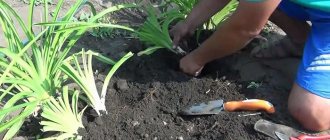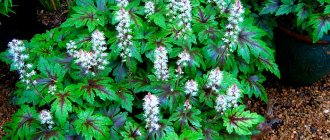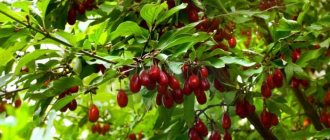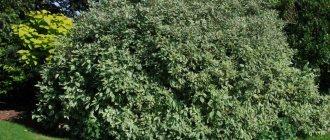Author:
Natalia
Category: Garden plants Published: February 21, 2019Added: July 12, 2020
shrub (lat. Euonymus) is a genus of low evergreen and deciduous woody plants of the Euonymus family, which includes more than two hundred species. In nature, euonymus is distributed in Europe, Asia, Australia and America - throughout the Northern Hemisphere, preferring valleys, floodplains and undergrowth of mixed forests. The Latin name for euonymus roughly translates to “tree of good name” or “glorious tree.” Among the Slavs, euonymus has many names: night blindness, lady's eyes, bruslina, burusklen, mersklet, kislyanka, dereskled, lingonberry, heather, privet, wolf's bast, wolf's earrings, saklak and blind-cured. Many types of euonymus are cultivated as ornamental plants; in particular, euonymus is used in landscape design to decorate outbuildings or fences. A hedge made of euonymus looks picturesque in the garden, and it attracts the eye both in summer and autumn. The species Warty Euonymus and European Euonymus are of practical importance, since it was in their bark and stems that gutta-percha was discovered.
Planting and caring for euonymus
- Planting: in early spring or during leaf fall.
- Lighting: Variegated species need bright light, while plants with solid-colored leaves prefer partial shade.
- Soil: light, drained, fertile, neutral or slightly alkaline.
- Watering: as needed: during the season with normal rainfall, the plant is not watered at all.
- Feeding: complex mineral fertilizer in early spring and autumn.
- Pruning: in early spring or after fruiting, for sanitary purposes, as well as to give the crown an ellipsoidal or conical shape.
- Reproduction: by seeds and vegetatively: by dividing the bush, cuttings and layering.
- Pests: caterpillars, spider mites, aphids and mealybugs.
- Diseases: trunk rot and powdery mildew.
Read more about growing euonymus below.
Euonymus pruning
Pruning helps keep the bush healthy and create the desired decorative appearance. Carry out the first pruning in the spring before the leaves appear. This haircut is considered preventive and helps to promote active branching. To do this, remove dried branches and thin out dense areas.
Do the second pruning in the fall after fruiting. Autumn haircut is the most interesting. During this period, you can give free rein to your imagination and conduct experiments. Creative pruning will result in a unique shrub shape.
Euonymus plant - description
The euonymus flower has shoots of a tetrahedral or round cross-section, on which cork growths sometimes form. In nature, some types of euonymus reach a height of 4 meters. Euonymus leaves are simple, opposite, shiny, jagged, dark green in color, but some varieties are distinguished by cream, white or silvery spots in the center or on the edges of the leaf blade. Euonymus blooms with inconspicuous yellow-greenish, cream or burgundy flowers that emit an unpleasant odor and are collected in 4-5 pieces in brushes or corymbs.
The fruit of the euonymus is a dry, leathery, four- to five-locular capsule with seeds, spiny or winged, which, depending on the type, acquires a pink, scarlet, crimson, burgundy, yellow or dark purple color when ripe. The stems of the euonymus are also painted in bright colors. Euonymus fruits, like all other parts of the plant, are poisonous.
Euonymus medicinal properties
Euonymus has long been used for medicinal purposes. This plant helps cope with many diseases. The bark, branches, seeds and leaves have medicinal properties. They contain many useful substances: carbohydrates, vitamin C, sucrose, higher fatty acids, alkaloids, tannins.
Various decoctions and tinctures help normalize blood pressure, normalize the functioning of the heart muscle, and cure diseases of the stomach and intestines. Euonymus is also used to treat nervous disorders and headaches.
Recipes for making tincture and decoction
Decoction for migraines : take a few branches, pour two glasses of water over them and boil for five minutes, let the decoction cool. Take two tablespoons three times a day for a week, then take a month break.
Tincture for hypertension : mix bark and alcohol in a ratio of 1:10. For example, ten grams of bark and one hundred grams of alcohol. Let the medicine sit for two weeks. Take seven drops three times a day for two weeks, then take a month break.
Planting euonymus
When to plant euonymus
The best time for planting euonymus is the beginning of spring, although autumn planting of euonymus is also acceptable. It is good if the site for the euonymus is in light partial shade, although the variegated euonymus prefers bright sunlight. The soil for euonymus should be light, fertile, permeable and, preferably, slightly alkaline or neutral. Acidic soil must be limed before planting. In addition, euonymus does not like high groundwater levels.
When choosing a site for euonymus, keep in mind that it grows greatly in width, and some species grow in height, so do not plant the plant too close to trees and maintain sufficient distance between bushes and buildings. It is better to plant dwarf species of euonymus in large boxes or pots, keep them in the garden in the summer, and bring them into a cool room for the winter. Thus, the same plant can be considered both as a garden euonymus and as an indoor euonymus.
How to plant euonymus
The planting hole for euonymus, dug at least two weeks before planting, should be one and a half times larger in volume than the root system of the seedling. Mix the top layer of soil removed from the hole with compost. Add a layer of sand or broken brick to the bottom of the hole as drainage, then a little soil with compost, and if the soil in the area is acidic, then add 200 g of slaked lime to each planting hole, mixing it with compost and soil.
Lower the euonymus seedling into the hole, carefully straighten its roots and fill the hole with the same mixture - soil with compost, compacting it as the space is filled so that air pockets do not form. The root collar of the seedling should be flush with the surface of the site. If you decide to plant euonymus seedlings for a hedge, it is better to dig a trench for this. Immediately after planting, water the euonymus and do this daily for a week.
Propagation by lignified cuttings
Today, this is the most convenient, frequent and at the same time ancient method of reproduction, which has many advantages and is very easy for humans to understand.
It does not take much time and does not cause discomfort. It makes it possible at home not to lose the characteristics of certain species, since it completely corresponds to the mother specimen.
The most important factors: the condition of the stems, timely protection from contact with light, oxygen, moisture and heat. The sooner the stem stops being exposed to light, the faster the roots develop and grow, so if you do not pay due attention to this, you can destroy even the most powerful shoots.
Lignified cuttings
Heat will be very useful if the soil is wet, in which case it is advisable to select areas with direct sunlight, but if the soil is dry, then it needs watering accordingly. If the roots dry out, this can lead to death. The soil should always be slightly damp and loose; it should be wetted at least 15 centimeters deep.
Euonymus care
Growing euonymus
Watering the euonymus is carried out as needed. To make it easier for you to care for your euonymus in the garden, mulch the tree trunk circle with dry soil immediately after watering. Subsequently, loosen the soil in the tree trunk circle a day or two after watering at least three times a season. But if it rains regularly, do not water the euonymus at all - it does not need a lot of water, and excess moisture in the roots will only harm it. Caring for euonymus involves feeding the plant twice a day during the spring-summer season with mineral fertilizers: the first time in the spring, the second time in the fall.
Pruning euonymus
The euonymus loves a haircut, it reacts to it with active branching, so there is no need to be afraid to trim the euonymus. Due to the fact that most of the euonymus fruits are a decoration, formative trimming of the euonymus is carried out either in early spring or after fruiting; during the growing season, only partial sanitary thinning, removal of weak shoots and pinching of the tops can be used. Using pruning, the crown of the euonymus is formed - conical or ellipsoidal. Many people prefer to form a standard tree from euonymus.
Pests and diseases of euonymus
The main pests of euonymus are aphids, mealybugs, spider mites and caterpillars.
Spider mites and aphids feed on euonymus sap, leaving light, silvery puncture points on the leaves, causing the leaves and young shoots to become deformed. The fight against these pests is carried out using three times weekly treatment of euonymus with Actellik solution at the rate of 1-2 ml of the drug per liter of water.
Mealybugs, which form cotton wool-like deposits and honeydew on euonymus leaves, are destroyed by two-stage treatment of the plant with Aktara, Confidor, Fitoverm with a break of a week or ten days.
As for caterpillars, if you notice their nests on the euonymus, it is better to remove them manually. By the way, pay attention: if caterpillars are found on the euonymus, then the neighboring apple trees and other fruit trees are clean! It seems that the euonymus lures pests to itself in order to save your harvest.
Among the diseases, euonymus can be affected by powdery mildew and trunk rot. Trunk rot is a serious fungal disease that is difficult to treat; it is easier to play it safe and carry out preventive treatment of euonymus in spring and autumn with a one percent Bordeaux mixture or preparations that replace it. Affected areas of the plant must be removed and burned, and if the damage is too severe, the entire plant will have to be burned.
A fungal disease is also such a common disease as powdery mildew, and it is combated with fungicides Fundazol, Topaz, Skor or Previkur, and there should be 3-4 treatment sessions at intervals of a week.
Features of care
The shrub will need to be provided with timely watering. To facilitate the process of caring for euonymus, experienced gardeners recommend immediately mulching the tree trunk area, and also be sure to loosen the soil after watering. It is worth remembering that excess moisture can harm the plant, since stagnation of water often results in rotting of the horse system.
Therefore, it is better to water after the top layer of soil has completely dried. As for feeding the bush, it is quite enough to apply fertilizer once in spring and autumn.
One of the ways to care for a shrub is to prune it. As a result of this procedure, the euonymus begins to branch more actively. It is recommended to form a crown either in early spring or in autumn after the fruiting process. Most often, gardeners prefer a conical and ellipsoidal crown.
The evergreen shrub tolerates winter quite well, but young euonymus (up to 3 years old) is still advised to be covered with straw or spruce branches. In addition, it is worth mulching the area around the trunk with peat or sawdust.
Euonymus propagation
How to propagate euonymus
Euonymus propagates by seeds, layering, dividing the bush and cuttings. Varieties with variegated, red and yellow leaves reproduce exclusively vegetatively.
Reproduction of euonymus by layering
In spring, low-growing shoots of the mother plant are bent to the ground, placed in a groove previously made in the soil, secured in it and sprinkled with soil, leaving only the tip of the shoot on the surface. Such cuttings easily form their own roots, and after rooting they can be transplanted to a permanent place.
Propagation of euonymus by cuttings
Euonymus cuttings are cut from the tops of semi-lignified shoots in June or July from plants no younger than five years old. The length of the cutting is about 7 cm, it should have one internode. The cut of the cutting is treated with a root former, planted in a mixture of peat and sand and kept under a film in a cool, bright place. After one and a half to two months, the rooted cuttings are planted in open ground on a training bed and grown.
Reproduction of euonymus by root suckers
Strong root shoots no more than 40-50 cm high are separated from the mother plant in early spring, as soon as the soil warms up. The thickness of the root of the scion should be at least one and a half centimeters, and the length 25-30 cm. Without shaking off the soil from the roots, the scion should be immediately transplanted to a permanent place or grown to the desired size.
Reproduction of euonymus by dividing the bush
This method is convenient for propagating dwarf varieties, since their root system is shallow and produces fresh root shoots every year. Carefully cut off the root shoots along with part of the rhizome from the mother plant with a shovel, cut the shoots by 2/3 and plant them in a permanent place. The euonymus tolerates this procedure easily and painlessly.
Propagation of euonymus by seeds
It is better to sow freshly collected euonymus seeds directly into the soil in the fall, then mulch the planting for the winter with leaves or straw. If you decide to sow euonymus in the spring, stratify the seeds for six months in the refrigerator, but before that, soak them in water for a couple of days.
Euonymus transplant
The main reason for changing the habitat is the active growth of euonymus or the obsolescence of the soil in the pot. The best time for transplantation is spring.
When replanting a plant, you need to choose a box or pot for it that is five centimeters larger than the previous one. If you want to stop the growth of euonymus, choose a container of the same diameter, but smaller in depth.
Young shrubs need to replace the pot every year. More mature specimens are replanted every two years. Large shrubs cannot be physically replanted, so you can only get by by replacing the top layer of soil.
Euonymus in winter
Euonymus in autumn
We hope that planting and caring for euonymus during the growing season did not seem tedious to you. It is easy to care for the plant even before the onset of winter. When the seed pods begin to crack, it is time to collect the seeds. Immediately after collection, euonymus seeds are planted in moistened soil, having first removed the seed plants and treated the seed with a pink solution of potassium permanganate. Crops are covered with straw or dry fallen leaves for the winter.
Wintering of euonymus
Young plants that are under three years old must be covered with spruce branches or dry leaves for the winter, otherwise they may die. Adult bushes overwinter without shelter, but to prevent the roots from freezing in a snowless winter, it would be wise to mulch the tree trunk with sawdust or leaves.
Watering euonymus
After planting, water the bush well. This should be done every day for the first week. Then water as the soil around the bush dries out. Try not to allow water to stagnate in the soil. Excessive humidity will harm the euonymus.
During dry periods, mulching will help retain moisture in the soil. You can use shredded wood or pine bark for this. Apply a layer of mulch twenty centimeters around the bush and water it.
Types and varieties of euonymus
There are many types of euonymus in nature, and there are many of them in culture. We offer you an introduction to cultivated species of euonymus, as well as their varieties. Let's start with the types that have already been mentioned in this article.
Euonymus verrucosa (Euonymus verrucosa)
Distributed in nature in the European part of Russia, in the mountains of Southern, South-Eastern and Central Europe. It is a shrub up to two meters high or a tree five to six meters high with bright green shoots and branches strewn with black warts. The leaves are light green, the flowers are brownish in color, the fruits are pink with red-brown buds. In autumn, this species is especially attractive: the leaves turn pink on the bright green shoots. Euonymus warty grows slowly, it is shade-tolerant and unpretentious, and is often used in ornamental gardening.
Pests of euonymus
Spider mite - white cobwebs appeared on the shoots, and black dots on the leaves. To get rid of the pest, treat the leaves and stems with a soap-alcohol solution.
Aphids - shoots and leaves are covered with small green or brown insects. Aphids are the cause of many beige spots. A soap solution or pine needle tincture will help combat the pest.
Diseases and pests
There are not many diseases and pests that can bother representatives of this species. All thanks to the unpretentiousness and cold resistance of the plant. However, with excessive cooling and humidity, the following pests and diseases may appear:
- if a white coating is noticeable on the leaves, then you should start fighting powdery mildew;
- if the plant grows in a dark place, the leaves may begin to lose their brightness;
- baldness in the lower part of the stem, drying of the tips of the leaves may indicate insufficient moisture or a too dry climate;
- The main problem for gardeners is root rot. Its appearance indicates excessive moisture in the soil or lack of drainage. It is worth reducing watering and starting to loosen the soil once a week;
- insects that like to feast on euonymus are mealyworms and spider mites. Pests begin to eat the plant from the lower tiers;
- holes on the leaves indicate the appearance of aphids. You should immediately treat the plant with medications.
Thus, the warty euonymus is an unpretentious plant that fits perfectly into the landscape and design of a personal plot or summer cottage area. The variety of varietal species allows you to grow euonymus in different weather conditions.
Euonymus is a plant that is famous for its poisonous properties. The name comes from the Greek goddess, whose name translated means “mother of the Furies.”
Euonymus can be considered both a garden and indoor plant. The most optimal period for planting is spring, although you can also deal with this issue in the fall. You need to carefully and very carefully choose a site; the plant is unpretentious, although it loves sunlight, but partial shade is also fine.
The soil should not be very acidic; neutral, permeable soil is best. It is imperative to take into account that the euonymus tends to grow in breadth, and sometimes even upward, so the area should be spacious, away from other trees, bushes, and flowers, to make it easier to keep a distance.
Varieties
Distinguished by the diversity of Fortune's euonymus varieties, gardeners can choose the one that fits perfectly into the landscape design of the site.
- Emerald Gold (Emerald Gold) - Golden emerald
Height - 0.3 m. Color: rich emerald or dark olive with golden lemon or yellowish edging, in autumn - bright pink or reddish. The berries are burgundy in color. It has the longest growing season, which can last 5 years.
- Emerald Gaiety (Emerald Haiti) - Emerald Joy
Height - 0.2 m. Color: emerald with a clear white border, pinkish in autumn. Looks good for decorating rabatkas.
- Silver Queen (Silver Queen) - Silver Queen
Height - 0.7 m. Color: bright green with white edging, pink in autumn. A liana-forming plant, often used to decorate a stand or trellis. Fast growing variety. Doesn't bloom or bear fruit.
- Interbolwi (Interbolwi)
Height - 0.3 m. Color: dark green with a large expressive yellowish-whitish spot in the center. It is usually used to form borders and fill empty spaces on the site. Creates a dense yellow-green carpet. Resistant to frost, diseases and pests.
- Blondy
It is distinguished by its rapid growth rate. Height - 0.6 m. Likes to climb up supports, so it is often used in vertical landscaping areas. Color: rich green with a large yellowish-white spot in the center.
- Coloratus (Coloratus) - Variegated
Height - 0.4 cm. Crown diameter - 4 times larger: up to 1.5 m. Color: rich emerald, purple in autumn. One of the most frost-resistant varieties of euonymus Fortune.
- Sunspot (Sunspot) - Sunny Bunny
Height - 0.25 m. Length of shoots - 1.2 m. Squat, compact, spherical shrub. Doesn't grow much. Color: large yellow-lemon spot in the middle of the leaf on a green background. Requires shelter for the winter.
- Variegatus (Variegata/Variegatus) - Multi-colored
Height - 0.3 m. Color - green with white edging; color remains in autumn.
- Harlequin (Harlequin) - Harlequin
Height - 0.25 m. Leaf color: on a white-green background - pinkish, yellowish and creamy inclusions. A distinctive feature is the shoots are white. Prefers to grow in shaded places.
- Golden Harlequin (Golden Harlequin) - Golden Harlequin
Not much different from the previous variety. A little higher and the shade of the foliage is brighter. Height - 0.4 m. Color: a mixture of green, yellow-golden, white and cream, a slight pinkish color appears in autumn. A distinctive feature is that the flowers have a beautiful blue tint. No other variety has this effect.
- Vegetus (Vegetus)
It has a high growth rate and easily entwines supports. It looks like a thick carpet. Color of matte leaves: dark green with a large number of whitish veins; color remains in autumn and winter.
- Minimus (Minimus) - Baby
Dwarf variety. Miniature compact bushes no more than 20 cm high. Leaves in the form of small medallions with a diameter of only 1 cm. In color - a mini copy of the above-described Vegatus variety. It grows slowly. Used in alpine slides and rockeries. Does not tolerate waterlogging.
- Canadale Gold
Height - 0.8 m. Compact shrub. The color is green with a yellow border; the color remains the same in autumn and winter.
General botanical description
The description was first given by the English scientist, gardener and botanist Robert Fortune, after whom the shrub was named.
This is a ground cover plant that does not shed its leaves in the winter. Due to its highly decorative properties, it is actively used in landscape design. It is also rapidly gaining popularity because it is highly frost-resistant. Although it loves sunlight, it tolerates partial shade well. Grows for a long time without watering in hot weather. Easy to care for.
Latin name: Euonymus fortunei.
The average height of Fortune's euonymus is 0.3 m. The crown diameter is 0.5 m and more. However, these parameters largely depend on the variety and age of the plant. This can be seen in the comparison table:
Leaves:
- do not fly around for the winter;
- oval-ellipsoidal;
- with a pointed top and jagged edges;
- leathery and dense;
- on a dark green, emerald background, whitish-yellow spots, dots, veins, inclusions stand out;
- in some varieties they turn pinkish or reddish in autumn.
Escapes:
- creeping;
- upon contact with the soil, they form nodular roots that cling to the foundation;
- As a result, they grow shallowly into the ground or rising up the supports.
Flowers:
- small;
- inconspicuous, lost in the foliage;
- whitish-yellow, olive color;
- flowering period - from mid-May to June, some varieties may be out of schedule;
- It does not bloom in central Russia.
Fruit:
- greenish, with a whitish tint (in rare varieties - red);
- smooth;
- elastic;
- look like balls with a diameter of 3-4 cm;
- ripen in August-September, remain on the bush until late autumn or even throughout the winter, but not in central Russia;
- contain poisonous toxins that can cause poisoning.
The territorial homeland of Fortune's euonymus is China. In its natural habitat it can be found in undergrowth, valleys and floodplains. In nature, the height of the bush can reach 3 m.
Landing
Planting Fortune's euonymus does not require any special skills; you only need to know a few nuances. It is best propagated by cuttings, but other methods can be used - seeds, seedlings or cuttings.
General recommendations
- Soil requirements: loose (for good ventilation), fertile, neutral pH, drainage is desirable.
- Plant in well-lit areas, but so that direct sunlight does not fall on the bush.
- The time is mid-spring, when the soil warms up thoroughly. It is better not to plant in open ground in autumn.
- For 2 weeks after planting, provide the plant with regular watering, preventing the soil from drying out.
- If it is a ground cover, no more than 5 bushes are planted per 1 m2.
Soil recipe No. 1:
- 5 kg of leaf soil;
- 1 kg of turf;
- 3 kg of humus;
- 1 kg of sand.
Soil recipe No. 2:
- 3 kg of peat;
- 3 kg of humus;
- 3 kg of turf;
- 2 kg wood ash.
If the soil on the site is already fertile, the mixture does not need to be prepared.
Seeds
Fortune's euonymus is not recommended to be propagated by seeds for several reasons. Firstly, shifts are difficult to assemble. Secondly, it's too troublesome. Thirdly, extremely low germination rate. Fourthly, you will have to wait a long time for an adult plant to grow. If you still decide to use this method, proceed according to the following scheme:
- In early autumn, ripened seeds are collected.
- For several months they are exposed to low temperatures - stratification.
- In January they are soaked in a weak manganese solution.
- Planted in a container with pre-prepared soil (a mixture of turf and sand).
- In April, the seedlings are planted in separate containers.
- It is recommended to grow the plant in a flower pot at home for a year.
- And only next year in May they should be planted in open ground.
Although, unlike other euonymus, Fortune is a ground cover, and many people plant it directly on the plot already in the first year of its life in May. In autumn, young bushes must be covered for the winter.
Seedlings
If you buy a seedling, it must be at least 3 years old, since at this age a strong root system has already been formed. Planting pattern:
- Dig a planting hole that should be twice the volume and length of the root.
- Fill one third of it with prepared soil (see recipe above).
- Compact.
- Lay out a drainage layer (crushed stone, sand, crushed brick), sprinkle with earth.
- Place the bush in the hole.
- Cover with the soil prepared according to the recipe.
- Lightly (not too tightly!) compact.
- Water generously.
- The next day, loosen.
- Mulch with sawdust or humus.
Many people prefer to plant Fortune's euonymus as seedlings. If they are of high quality and everything is done correctly, the survival rate is almost 100%. They can be bought or obtained by dividing the rhizomes of the bush into parts.
Bends
Another very popular method of reproduction:
- At the beginning of summer, carefully bend back 2-3 lower branches.
- Make small cuts in the middle of the shoots from the bottom to form roots.
- Wet the cut area generously with Kornevin's solution (Epin or Heteroauxin).
- Since the shoots of Fortune's euonymus are capable of clinging to literally any foundation and they are creeping, most often fixation with staples is not required.
- Sprinkle the cut area with soil.
- In the fall, separate the branch branches from the main bush, dig them up and replant them in the right place.
It is better to form several branches at once, because for various reasons not all of them take root.
Cuttings
The most popular method of reproduction. The scheme is as follows:
- Propagation by cuttings is allowed in autumn or late summer.
- Using garden shears, carefully cut off a suitable shoot (healthy, young, without damage) about 10 cm long.
- Prepare a solution of Kornevin (Epin or Heteroauxin) according to the instructions. Immerse the cut of the cuttings in it for half an hour.
- Prepare a soil mixture: humus, peat, turf, sand, ash and nitroammophoska.
- Plant the cuttings in a container with prepared soil mixture.
- Cover with multilayer polyethylene or glass. Place in the shade. Water twice a week.
- A month later, when the euonymus takes root, transplant it into pots.
- In spring, transplant into open ground.
Fortune's euonymus in landscape design
The shrub is actively used in the formation of beautiful borders and hedges. Plants are used to highlight functional areas on the site. Euonymus is a versatile plant that can serve as a ground cover for both sunny and shady areas, as an edging plant along paths, as a cover plant on slopes, as a focal plant, or to hide unsightly fences and buildings.
To combine with the crop, barberries, periwinkles, and spirea are used. Another great solution is to plant bushes next to conifers, for example, dwarf thujas, junipers, and boxwoods. With the help of plants, original multi-level compositions are formed; for this, they are planted with different summer flowers in certain tiers.
Description and features of Fortune's euonymus
This is an evergreen deciduous plant that can develop in climatic conditions that are harsh for shrubs of this species, when the air temperature drops to -25°C.
The structural features of the plant help it survive frosts in winter. Its numerous shoots spread above the surface of the earth and are covered with a cap of snow, which protects the bush from freezing.
Lat. Euonymus fortunei 'Sunspot'
The plant has leathery leaves reaching 4 cm in length with uneven and slightly curved edges. The color of the leaves of decorative forms of shrubs varies:
- "Emerald Gaiety" - green with a white border in summer, raspberry pink in winter;
- "Minimus" - dark green all seasons;
- "Variegatus" - green with a white border in summer, pale pink with a light green center in winter;
- "Sunspot" - dark green with a yellow center all seasons;
- 'Emerald Gold' has green leaves with a bright yellow edge that turns pink in winter;
- "Coloratus" - dark green leaves in summer turn crimson in winter.
This variety of color shades is united by the glossy shine characteristic of the leaves of the described plant.
The homeland of the bush is China. The plant has become widely known among gardeners since 1907, when it began to be cultivated in the Black Sea region and in Ukraine. The evergreen shrub rarely reaches 60 cm in height; its long side shoots, growing up to 3 m, make it especially decorative.
They tend to cling to any support and form rooting nodes.
All forms of euonymus have inconspicuous and small flowers of pale green color, collected in inflorescences of 3-5 pieces. The decorative value of the shrub is given by the fruits, during the ripening of which the plant is transformed. The fruits are four-part capsules, inside which there are numerous seeds, covered with a fleshy aneurysm.
At the beginning of formation, the boxes are pale green in color, and during full ripening they acquire bright shades from dark purple to soft pink. Such bright colors enliven the garden plot in September, when many plants wither and lose their attractiveness.
The toxicity of the bush has been greatly exaggerated. Euonymus contains alkaloids in small quantities; poisoning of an adult occurs when eating at least 30-35 berries of the bush.
Expert opinion
Yulia Yurievna
I have a large garden and vegetable garden, several greenhouses. I love modern methods of cultivating plants and mulching the soil, and I share my experience.
Ask a Question
Let's take a closer look at the euonymus fortunei variety to evaluate the full range of possibilities for decorating a site. It is important to study not only the color of the crown, but also the size, shape of the leaves and requirements for growing conditions and care. Vegetus are small low shrubs that have rich green, dark leaves, matte and oval. The veins on the foliage are light, often white. The plant develops quickly, filling the area allotted to it. If on the path of such a bush there is a stone or other plant, it can entwine it. Minimus - differs not only in the dark color of the crown. This is a miniature plant, the leaves are elliptical and the branches are very thin. It is resistant to cold and requires little maintenance. Emerald Gold - plants develop rather slowly and are not large. The height of an adult specimen, as a rule, is no more than 25-30 centimeters. The border is not only yellow, but golden. The foliage is pointed. The leaf dimensions do not exceed 2 centimeters. Emerald Gaiety - small plants, reaching a height of 20-25 centimeters. The leaves are oval and have an uneven edge. Emerald Gaiety is often used in landscape design. Disadvantages include instability to severe frosts. In cold regions, shelter is required. Silver Queen are large shrubs that grow quickly. The leaves have a rich green color. The border is white. When the temperature drops, the white color on the leaves changes to pink. SunSpot is a short variety. Has a dense crown. The leaves are oval. A distinctive feature is resistance to frost.











